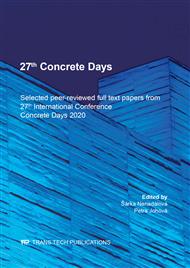p.28
p.35
p.41
p.48
p.54
p.60
p.66
p.72
p.78
Fracture Resistance of AAAS Composites with Ceramic Precursor
Abstract:
The paper deals with selected alkali-activated aluminosilicate (AAAS) composites based on ceramic precursors in terms of their characterization by mechanical fracture parameters. Composites made of brick dust as a precursor and an alkaline activator with a silicate modulus of Ms = 0.8, 1.0, 1.2, 1.4 and 1.6 were investigated. The filler employed with one set of composites was quartz sand, while for the other set it was crushed brick. The test specimens had nominal dimensions of 40 × 40 × 160 mm and were provided with notches at midspan of up to 1/3 of the height of the specimens after 28 days. 6 samples from each composite were tested. The specimens were subjected to three-point bending tests in which force vs. displacement (deflection at midspan) diagrams (F–d diagrams) and force vs. crack mouth opening (F–CMOD) diagrams were recorded. After the correction of these diagrams, static modulus of elasticity, effective fracture toughness, effective toughness and specific fracture energy values were determined using the Effective Crack Model and the Work-of-Fracture method. After the fracture experiments, informative compressive strength values were determined from one of the parts. All of the evaluations included the determination of arithmetic means and standard deviations. The silicate modulus values and type of filler of the AAAS composites significantly influenced their mechanical fracture parameters.
Info:
Periodical:
Pages:
54-59
Citation:
Online since:
August 2021
Authors:
Price:
Сopyright:
© 2021 Trans Tech Publications Ltd. All Rights Reserved
Share:
Citation:


